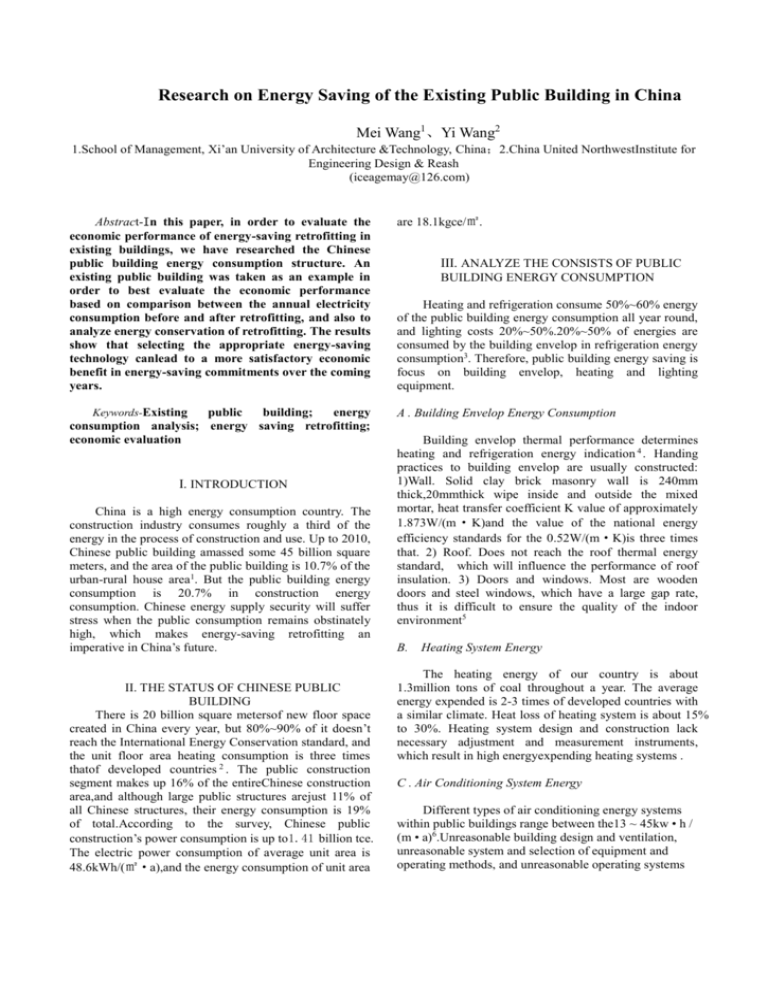1030198 - Extra Materials
advertisement

Research on Energy Saving of the Existing Public Building in China Mei Wang1、Yi Wang2 1.School of Management, Xi’an University of Architecture &Technology, China;2.China United NorthwestInstitute for Engineering Design & Reash (iceagemay@126.com) Abstract-In this paper, in order to evaluate the economic performance of energy-saving retrofitting in existing buildings, we have researched the Chinese public building energy consumption structure. An existing public building was taken as an example in order to best evaluate the economic performance based on comparison between the annual electricity consumption before and after retrofitting, and also to analyze energy conservation of retrofitting. The results show that selecting the appropriate energy-saving technology canlead to a more satisfactory economic benefit in energy-saving commitments over the coming years. are 18.1kgce/㎡. Keywords-Existing public building; energy consumption analysis; energy saving retrofitting; economic evaluation A . Building Envelop Energy Consumption I. INTRODUCTION China is a high energy consumption country. The construction industry consumes roughly a third of the energy in the process of construction and use. Up to 2010, Chinese public building amassed some 45 billion square meters, and the area of the public building is 10.7% of the urban-rural house area1. But the public building energy consumption is 20.7% in construction energy consumption. Chinese energy supply security will suffer stress when the public consumption remains obstinately high, which makes energy-saving retrofitting an imperative in China’s future. II. THE STATUS OF CHINESE PUBLIC BUILDING There is 20 billion square metersof new floor space created in China every year, but 80%~90% of it doesn’t reach the International Energy Conservation standard, and the unit floor area heating consumption is three times thatof developed countries 2 . The public construction segment makes up 16% of the entireChinese construction area,and although large public structures arejust 11% of all Chinese structures, their energy consumption is 19% of total.According to the survey, Chinese public construction’s power consumption is up to1.41 billion tce. The electric power consumption of average unit area is 48.6kWh/(㎡·a),and the energy consumption of unit area III. ANALYZE THE CONSISTS OF PUBLIC BUILDING ENERGY CONSUMPTION Heating and refrigeration consume 50%~60% energy of the public building energy consumption all year round, and lighting costs 20%~50%.20%~50% of energies are consumed by the building envelop in refrigeration energy consumption3. Therefore, public building energy saving is focus on building envelop, heating and lighting equipment. Building envelop thermal performance determines heating and refrigeration energy indication 4 . Handing practices to building envelop are usually constructed: 1)Wall. Solid clay brick masonry wall is 240mm thick,20mmthick wipe inside and outside the mixed mortar, heat transfer coefficient K value of approximately 1.873W/(m · K)and the value of the national energy efficiency standards for the 0.52W/(m·K)is three times that. 2) Roof. Does not reach the roof thermal energy standard, which will influence the performance of roof insulation. 3) Doors and windows. Most are wooden doors and steel windows, which have a large gap rate, thus it is difficult to ensure the quality of the indoor environment5 B. Heating System Energy The heating energy of our country is about 1.3million tons of coal throughout a year. The average energy expended is 2-3 times of developed countries with a similar climate. Heat loss of heating system is about 15% to 30%. Heating system design and construction lack necessary adjustment and measurement instruments, which result in high energyexpending heating systems . C . Air Conditioning System Energy Different types of air conditioning energy systems within public buildings range between the13 ~ 45kw • h / (m • a)6.Unreasonable building design and ventilation, unreasonable system and selection of equipment and operating methods, and unreasonable operating systems have led to the high energy consumption with in air conditioning systems of public buildings7. D. Building Equipment Energy Consumption of Electrical Survey indicates that building energy consumption of electrical equipment mainly reflects in the following areas: 1) Equipment efficiency. Not using the right equipment leads to low efficiency and high energy consumption, resulting in energy waste. 2) Air-conditioning equipment. Public buildings are always equipped with central air conditioning, while air conditioning cold caloric needs long-distance transport, during which losses of energy consumption in the transportation process are caused. 3) User habits. Actions such as daytime lights, keeping computers and air conditioning working when get off work all seem to be insignificant, but the amount of potential actual energy saving could be huge8. IV. EXISTING PUBLIC ENERGY SAVING BENEFIT ANALYSIS A. Simulation of Energy Consumption Data To achieve lower energy consumption is both the target of energy-saving in public buildings and the evaluation criteria. Accurately measuring or calculating the amount of energy consumption is fundamental for the proper economic evaluation of existing public buildings’ energy saving transformation 9 . Building energy simulation software can simulate the total energy consumption and the sub-entry energy consumption of reconstruction,which can be used to compare the levels of energy saving before and after, and soachieving the comparison and analysis of energy level of the energy saving transformation. B . Energy Transformation of The Economic Model When conducting the economic evaluation of public buildings energy-efficiency, we must consider the relationship between the energy-saving one-time investment and the building energy costs. We must also take into account both the economic and energy-saving standards of the comprehensive benefits. In this paper, by using the financial evaluation method to conduct the economic evaluation of public buildings’ energy saving transformation, we analyzed and calculated the costs of energy-saving and energy saving benefits after the transformation, and calculated the economic evaluation index of the energy-saving project, all to study the profitability of energy-saving projects and best judge the economic feasibility of energy saving. C. Calculation Of The Cost Of Energy-saving The main difference between energy-saving building and non- energy-saving building is the material fee of the direct expense of a project, therefore, the estimation of the energy-saving construction cost is largely the analysis of the cost of consumption of energy-saving materials. Energy-saving costs include energy-saving materials’ costs and construction costs. I0 = ∑ki=1(a i + bi )si (1) The equation (1) shows the energy saving cost, the unit price of i kind construction materials used in the energy-saving building, the unit cost of construction of i kind materials used in the transformation, the quantity of i kind energy saving materials used in the energy saving building, while k is for the type of the energy-saving building materials used in energy-saving building. D. Calculation Of Energy-saving Benefits The reduced energy consumption fees of public buildings energy-saving transformation can be called energy-saving gains. The characteristics of public buildings in China's energy consumption are as follows: heating energy consumption is mainly in the north while air-conditioning and lighting energy consumption is in the south. Therefore, the income can be estimated with energy consumption index: I0′ = (𝑄𝑡 − 𝑄𝑡′ )p (2) (2) shows the energy saving benefits of the existing public buildings and the power consumption difference of the energy-saving construction transformation; p is for energy prices. E. Analysis Model Of Energy-saving Project Financial Evaluation Of In this paper, giving full consideration to energy prices and the discount rate, the actual energy efficiency has an impact on the cost changes of existing public buildings’ energy-saving.Energy efficiency also impacts uponcumulative annual net cash flow and net cash flow in calculating the energy-saving payback period, and in clarifying the economic benefits enjoyed during the operation period. Energy cost savings per year in net cash NCTt : NCTt = αp(Qt − Q′t )(F⁄P , μ, 𝑡)(P⁄F , i, 𝑡) flow10used (3) Because Energy-efficient buildings reduce energy consumption, the energy-efficient gains achieved by Energy-efficient buildings besides cost of its available energy saving in economic life used ANCTt : ANCTt = ∑n−1 t=1 αp(Q t − ′ )(F⁄ Qt P, μ, 𝑡)(P⁄F , i, 𝑡) − γI0 (4) Energy-efficient buildings in the course of the time of energy-saving benefits cover the cost of it’s energy saving retrofitting could be represented by dynamic investment recovery period Pt′ : Pt′ = 𝑚 − 1 + |ANCTm−1 | (5) NCTm In equation(5),(F/P,μ,n)is payment of the final value of the coefficient;(P/F,i,n)is discount factor is construction phases of economic life; α is actual energy saving efficiency; μ is the growth rate of energy prices; i is discount rate; is the year when cumulative NPV began to appear positive age. dust with a good sound insulation effect. When making energy-saving windows, the original single-layer hollow glass windows are replaced by single-layer steel sliding-sash window frames, which do not move. C. Building Energy Consumption After Energy-saving After the transformation of existing public buildings to maintain the structure summarized in table II: V. EXAMPLE ANALYSIS TABLE II A. Engineering Overview Energy saving design In this paper, the total construction area of 12,700square meters of a University Library is to be usedas an example of before and after annual energy consumption, energy-saving and cost analysis of energy saving. The library is located in Xi’an, and is in possession of anopen-shelf reading room, lecture hall, meeting rooms, other electronic reading rooms and various administrative spaces. The height of these respective spaces is 2.9meters, witha total of five layers. The building includes outer walls of reinforced concrete, an exterior wall outside the mortar, and brush brown acrylic paint. Retrofitting of the library before the insulation is regarded as beingpoor and has had a significant impact to the students self-study and borrowing experience. Table I is envelope overview. TABLE I Overview of existing public buildings envelope Name Materials Roof 20mm thick surface layer of fine aggregate concrete, waterproof layer,110mm thick reinfor ced concrete layer, 25mm thick plaster Wall Window B. Heat transfer coefficient / (W/(㎡·K)) 20mm thick cement mortar, 180mm thick clay brick, 20mm thick gray lime mortar Steel single layer pull/push window 2.7 Name Material Roof 25Mm thick extruded polyphone board 200mm thick aerated concrete block empty glass window Wall Window coefficient of heat transfer /(W/(㎡·K)) 0.97 0.75 2.7 The statistics, the library before and after the years of energy-saving power consumption, see Table III: TABLE III The library’s electric power consumption before and after retrofitting Name The library before energy saving transformation The library after energy saving transformation Years power consumption (kWh/㎡) 898760 436237 D. Energy Consumption Analysis Based on Economic Evaluation of Energy Saving Cost and Energy Saving Energy Saving Calculation of earnings The cost of energy-saving type (1) calculated with reference to the 2009 "construction project in Shaanxi Province lists" computing the price of materials. Cost Analysis of Energy Saving in Table IV below: 2.53 TABLE IV 5.0 Determination Of Energy-saving Design 1. Roof Roof heat transfer coefficient 2.7 W / (m • K);this higher than the "public building energy efficiency design standards";The roof being capped with 25mm thick extruded polyethylene board. 2. Wall Wall heat transfer coefficient is 2.53 W / (m • K); higher than the "public building energy efficiency design standards". Aerated concrete blocks are used to achieve better thermal insulation properties. 3. Window The project for the single-layer steel sliding sash windows, the heat transfer coefficient is 5.0 W / (m • K); the plastic-steel windows can reduce the external radiation on the human body, both hot and cold, and also Cost of energy saving retrofitting Energy-saving technology reform 25mm thick extruded polyphone board 200mm thick aerated concrete block Empty glass window Amount Quantities (㎡) Comprehensi ve unit price (yuan) Total price(yuan) 108.26 57673.34 4260.26 88.86 378566.70 2036.58 - 204.45 - 416378.78 852618.82 532.73 The current price of electricity in Shaanxi Province is 0.7486 RMB / kWh, energy saving retrofitting costI0 = 852618.82 RMB, the profit after energy saving retrofitting could be work out by equation(2).This library can save energy fee I0′ =346244.72yuan after retrofitting. E. Financial Analysis Of Energy Saving The assumed energy price growth rate is 7%. Assumed public building actual energy-saving efficiency is 100%, with a discount rate of6%. Because the public building energy-saving operational period must be short relative to its cost, the cost of the energy-saving rate-of-change is 100%, the construction ageis 1a, and operation period is 49a; where 1a refers to one full year. NCTt = 100% × 346244.72 × (F⁄P , 7%, 3)(P⁄F , 6%, 3) ANCTt = ∑49 t=1 100% × 346244.72 × (F⁄P , 7%, 𝑡)(P⁄F , 6%, 𝑡) − 852618.82 WhenANCTt ≥0,force t to assume integral values, the calculation shows that ANCT2 =-150296.37 yuan, ANCT3 =205819.78 yuan,t≥3a. Compute dynamic investment recovery period Pt′ : NCTt = 100% × 346244.72 × (F⁄P , 7%, 3)(P⁄F , 6%, 3) = 356116.16 |−150296.37| ′ Pt = 3 − 1 + = 2.4a 356116.16 Through analysis, the electric power consumption fell 51.46% after retrofitting, this in line with requirements that energy-saving buildings should save energy at around the 50%mark after retrofitting. When energy prices rose 7%,the dynamic investment recovery period sits at 2.4a. Chinese ‘Public Building Energy Efficiency Design Standards’ allow for the increasing of energy-efficient buildings only provided that the payback period does not exceed ten years, so retro-fitting is feasible in the library. VI. CONCLUSION This paper analyzes the composition of public building energy consumption and, on this basis, selected energy-saving measures in public buildings, as well as the use of financial analysis and economic evaluation of existing public buildings for energy saving. The results show that existing public buildings would be best served by taking full advantage of the energy-saving thermal performance of building envelope improvements as well as the use of natural ventilation; both with the view to improve energy efficiency and to reduce energy-saving costs associated with the running and maintenance of existing public buildings. REFERENCES [ 1 ] Building Energy Research Center of Tsinghua University,(2007). “2007 Annual Report on China Building Energy Efficiency”. [2] Jian-bang Liu, Wei Liu, “Study on integrated technology of energy-saving renovation existing public buildings in northern area of Jiangsu province”, Industrial Construction Vol.40,No.3,2010. [ 3 ] Building Energy Research Center of Tsinghua University,(2010). “2010 Annual Report on China Building Energy Efficiency. [4]Yan-bing Ye, “Research on energy saving reform of the existing public buildings in china ”, Industrial Construction Vol·36,No·1,2006. [5]Zimmermann M.IEA ECBCS ANNEX 50 Prefabricated Systems for Low Energy Renovation of Residential Buildings. Jahresbericht 2008[R].Swiss: EMPA,2009. [6] Yehie Rosenfeld, Igal M.Shohet. Decision Support Model for Semi-automated Selection of Renovation Alternatives [J]. Automation in Construction, 1999(8):503-510. [7] Pugh, C. The Costs and Benefits of Rehabilitation and Refurbishment [J]. Property Management, 9(2): 451-462. [ 8 ] Zhou Qi-chen,Qin Xuan and Zhan Chao-xi.(2010). “Economic Evaluation on Energy-saving Retrofit for Existing Building Based on Consumption Analysis”,Journal of Building Science,Vol.26,No.8. 53-57 [9] Ji Yuan,Fang Yong-ban and Tian Guo-hua,(2010). “Study on Energy-saving Renovation of Enclosures of Existing Public Buildings in Northern Area of JiangSu Province”,jourmal of Industrial Construction Vol.40,No.3,2010.30-33. [ 10 ] Xiao-jun Liu, “Engineering Economic”(book style), Northwestern University press.





